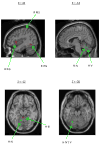Neural correlates of motor learning, transfer of learning, and learning to learn
- PMID: 20016293
- PMCID: PMC2796204
- DOI: 10.1097/JES.0b013e3181c5cce7
Neural correlates of motor learning, transfer of learning, and learning to learn
Abstract
Recent studies on the neural bases of sensorimotor adaptation demonstrate that the cerebellar and striatal thalamocortical pathways contribute to early learning. Transfer of learning involves a reduction in the contribution of early learning networks and increased reliance on the cerebellum. The neural correlates of learning to learn remain to be determined but likely involve enhanced functioning of the general aspects of early learning.
Figures





Similar articles
-
Possible mechanism for transfer of motor skill learning: implication of the cerebellum.Cerebellum. 2004;3(4):204-11. doi: 10.1080/14734220410018977. Cerebellum. 2004. PMID: 15686098 Review.
-
Older adults can learn to learn new motor skills.Behav Brain Res. 2007 Oct 1;183(1):118-22. doi: 10.1016/j.bbr.2007.05.024. Epub 2007 May 24. Behav Brain Res. 2007. PMID: 17602760 Free PMC article.
-
Neuroanatomical correlates of motor acquisition and motor transfer.J Neurophysiol. 2008 Apr;99(4):1836-45. doi: 10.1152/jn.01187.2007. Epub 2008 Feb 13. J Neurophysiol. 2008. PMID: 18272874
-
Cortico-cerebellar Networks Drive Sensorimotor Learning in Speech.J Cogn Neurosci. 2018 Apr;30(4):540-551. doi: 10.1162/jocn_a_01216. Epub 2017 Dec 6. J Cogn Neurosci. 2018. PMID: 29211651
-
Distinct contribution of the cortico-striatal and cortico-cerebellar systems to motor skill learning.Neuropsychologia. 2003;41(3):252-62. doi: 10.1016/s0028-3932(02)00158-6. Neuropsychologia. 2003. PMID: 12457751 Review.
Cited by
-
Cerebellar contributions to visuomotor adaptation and motor sequence learning: an ALE meta-analysis.Front Hum Neurosci. 2013 Feb 7;7:27. doi: 10.3389/fnhum.2013.00027. eCollection 2013. Front Hum Neurosci. 2013. PMID: 23403800 Free PMC article.
-
"There is more that unites us than divides us". Optimizing talent transfer processes by clustering 34 sports by their task, individual and environmental similarities.Front Sports Act Living. 2024 Nov 1;6:1445510. doi: 10.3389/fspor.2024.1445510. eCollection 2024. Front Sports Act Living. 2024. PMID: 39558962 Free PMC article.
-
HIIT the Road Jack: An Exploratory Study on the Effects of an Acute Bout of Cardiovascular High-Intensity Interval Training on Piano Learning.Front Psychol. 2020 Sep 10;11:2154. doi: 10.3389/fpsyg.2020.02154. eCollection 2020. Front Psychol. 2020. PMID: 33013550 Free PMC article.
-
Enhancing motor skill learning with transcranial direct current stimulation - a concise review with applications to stroke.Front Psychiatry. 2012 Jul 12;3:66. doi: 10.3389/fpsyt.2012.00066. eCollection 2012. Front Psychiatry. 2012. PMID: 22807918 Free PMC article.
-
A blended neurostimulation protocol to delineate cortico-muscular and spino-muscular dynamics following neuroplastic adaptation.Front Neurol. 2023 Jun 15;14:1114860. doi: 10.3389/fneur.2023.1114860. eCollection 2023. Front Neurol. 2023. PMID: 37396760 Free PMC article.
References
-
- Abeele S, Bock O. Transfer of sensorimotor adaptation between different movement categories. Exp Brain Res. 1993;148:128–32. - PubMed
-
- Ashe J. Force and the motor cortex. Behavioural Brain Research. 1997;87:255–69. - PubMed
-
- Bachman JC. Specificity vs. generality in learning and performing two large muscle motor tasks. Research Quarterly. 1961;32:3–11.
-
- Bock O, Schneider S, Bloomberg J. Conditions for interference versus facilitation during sequential sensorimotor adaptation. Exp Brain Res. 2001;138:359–365. - PubMed
-
- Bock O, Schneider S. Sensorimotor adaptation in young and elderly humans. Neurosci Biobehav Rev. 2002;26(7):761–7. - PubMed
Publication types
MeSH terms
Grants and funding
LinkOut - more resources
Full Text Sources
Other Literature Sources

